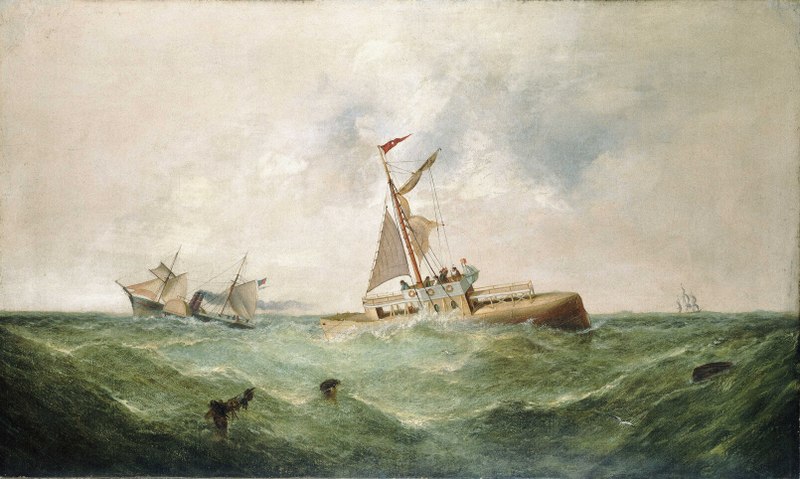335-Transporting Obelisks
Futility Closet
Greg Ross
4.8 • 748 Ratings
🗓️ 15 March 2021
⏱️ 32 minutes
🧾️ Download transcript
Summary

In the 19th century, France, England, and the United States each set out to bring home an Egyptian obelisk. But each obelisk weighed hundreds of tons, and the techniques of moving them had long been forgotten. In this week's episode of the Futility Closet podcast we'll follow the struggles of each nation to transport these massive monoliths using the technology of the 1800s.
We'll also go on an Australian quest and puzzle over a cooling fire.
Intro:
Science fiction writer Albert Robida proposed a president made of wood.
Norway's flag incorporates those of six other nations.
Sources for our feature on the Egyptian obelisks:
Bob Brier, Cleopatra's Needles: The Lost Obelisks of Egypt, 2016.
Martina D'Alton, The New York Obelisk, or, How Cleopatra's Needle Came to New York and What Happened When It Got Here, 1993.
Charles Edward Moldenke, The New York Obelisk, Cleopatra's Needle: With a Preliminary Sketch of the History, Erection, Uses, and Signification of Obelisks, 1891.
Henry Honeychurch Gorringe, Egyptian Obelisks, 1885.
Erasmus Wilson, Cleopatra's Needle: With Brief Notes on Egypt and Egyptian Obelisks, 1877.
Bob Brier, "The Secret Life of the Paris Obelisk," Aegyptiaca: Journal of the History of Reception of Ancient Egypt 2 (2018), 75-91.
Henry Petroski, "Engineering: Moving Obelisks," American Scientist 99:6 (November–December 2011), 448-452.
Bob Brier, "Saga of Cleopatra's Needles," Archaeology 55:6 (November/December 2002), 48-54.
P.W. Copeman, "Cleopatra's Needle: Dermatology's Weightiest Achievement," British Medical Journal 1:6106 (1978), 154-155.
"Machinery for Moving Cleopatra's Needle," Scientific American 41:21 (Nov. 22, 1879), 322.
"Landing of Cleopatra's Needle," Scientific American 39:4 (July 27, 1878), 55.
"Cleopatra's Needle," Scientific American 36:14 (April 7, 1877), 215-216.
Paul Brown, "Weatherwatch: The Perilous Sea Journey of Cleopatra's Needle," Guardian, April 8, 2020.
Marguerite Oliver, "Cleopatra's Needle: Egypt's Gift to England," Los Angeles Times, Sept. 20, 1987.
Cyrus W. Bell, "How They Took Cleopatra's Needle Down the Nile and by Sea to London," Toronto Star, Nov. 9, 1985.
"Now It Can Be Told; After 60 Years, Cleopatra's Needle Identifies Itself," New York Times, March 7, 1941.
"Cleopatra's Needle in London," New York Times, April 17, 1932.
"Obelisk Located in Central Park," New Britain [Conn.] Herald, Dec. 5, 1928.
Eli Benedict, "Cleopatra's Needle: Central Park Obelisk Is More Than 3,000 Years Old," New York Times, May 14, 1914.
"Cleopatra's Needle: How Well It Stands the English Climate," New York Times, June 6, 1890.
"Laying the Corner-Stone; Masons Preparing the Obelisk's Foundation," New York Times, Oct. 10, 1880.
"Hieroglyphics Deciphered," New York Times, Aug. 19, 1878.
"The Inscriptions on Cleopatra's Needle," New York Times, July 25, 1878.
"Raising the Cleopatra's Needle," New York Times, June 30, 1878.
"Cleopatra's Needle," Times, Feb. 16, 1878.
"Cleopatra's Needle," Graphic, Feb. 2, 1878.
"Cleopatra's Needle," Liverpool Mercury, Oct. 22, 1877.
"The Derelict Obelisk," New York Times, Oct. 19, 1877.
"Cleopatra's Needle," [London] Standard, Oct. 19, 1877.
"Cleopatra's Needle: Loss of the Obelisk Off Cape Finistere a Heavy Gale in Which the Steamer Lost Six Men in Rescuing the Crew From the Craft," New York Times, Oct. 18, 1877.
"Cleopatra's Needle in London," New York Times, Sept. 16, 1877.
"Cleopatra's Needle," Birmingham Daily Post, April 22, 1876.
"How Cleopatra's Needle Is to Be Moved," New York Times, Aug. 1, 1875.
"Cleopatra's Needle," New York Times, June 6, 1875.
"Cleopatra's Needle," Illustrated London News, June 21, 1851.
Listener mail:
invaluable.disclaimer.biographer on What3words.
"France Passes 'Sensory Heritage' Law After Plight of Maurice the Noisy Rooster," Guardian, Jan. 21, 2021.
Kristof Van Rompaey, "Buur stapt naar vrederechter voor haan die dagelijks 'meer dan 3.000 keer' kraait: 'Ben wegdoen zou een klap zijn voor onze kinderen'," Gazet van Antwerpen, June 30, 2020.
"The Gregorian Reform of the Calendar," Encyclopedia.com (accessed Mar. 6, 2021).
"Gregorian Calendar," Encyclopaedia Britannica (accessed March 6, 2021).
"Gregorian Calendar," Wikipedia (accessed Mar. 6, 2021).
"Adoption of the Gregorian Calendar," Wikipedia (accessed Mar. 6, 2021).
This week's lateral thinking puzzle was contributed by listener Tristan Shephard.
You can listen using the player above, download this episode directly, or subscribe on Google Podcasts, on Apple Podcasts, or via the RSS feed at https://futilitycloset.libsyn.com/rss.
Please consider becoming a patron of Futility Closet -- you can choose the amount you want to pledge, and we've set up some rewards to help thank you for your support. You can also make a one-time donation on the Support Us page of the Futility Closet website.
Many thanks to Doug Ross for the music in this episode.
If you have any questions or comments you can reach us at [email protected]. Thanks for listening!
Transcript
Click on a timestamp to play from that location
| 0:00.0 | Welcome to the Futility Closet Podcast, forgotten stories from the pages of history. |
| 0:14.9 | Visit us online to sample more than 11,000 quirky curiosities from a wooden president to a comprehensive flag. |
| 0:22.1 | This is episode 335. I'm Greg Ross. And I'm Sharon Ross. In the 19th century, France, |
| 0:28.6 | England, and the United States each set out to bring home an Egyptian obelisk. But each |
| 0:33.5 | obelisk weighed hundreds of tons, and the techniques of moving them had long been forgotten. |
| 0:38.3 | In today's show, we'll follow the struggles of each nation to transport these massive monoliths |
| 0:43.3 | using the technology of the 1800s. |
| 0:46.3 | We'll also go on an Australian quest and puzzle over a cooling fire. |
| 0:52.3 | The obelisks of ancient over a cooling fire. |
| 1:01.9 | The obelisks of ancient Egypt were some of the heaviest objects ever moved over land in the pre-industrial age. |
| 1:03.9 | Creating and raising them was a status symbol reserved to the pharaohs, a sign of enormous |
| 1:08.6 | wealth and power. |
| 1:10.2 | The average obelisk is a single piece of |
| 1:12.2 | granite weighing 250 tons, and the Egyptians moved and erected them using only ropes, |
| 1:18.0 | inclined planes, and rollers. They left no accounts of how they did this, and engineers still argue |
| 1:23.9 | over how it was accomplished. Eventually, Romans took control of Egypt and, impressed |
| 1:29.0 | with the obelisks, carried some across the Mediterranean, and re-erected them in Rome as trophies of |
| 1:34.4 | war. They too left no records as to how they'd done it, though we know they had several |
| 1:38.7 | mechanical devices that had been unknown to the Egyptians, such as the pulley, the derrick, |
| 1:43.5 | and the winch. After the Romans, |
| 1:45.6 | no one tried to move an obelisk for more than a thousand years, and by the Middle Ages, |
| 1:49.9 | the knowledge of how to do it had been lost. In 1585, when one obelisk was moved within Rome to a new |
... |
Please login to see the full transcript.
Disclaimer: The podcast and artwork embedded on this page are from Greg Ross, and are the property of its owner and not affiliated with or endorsed by Tapesearch.
Generated transcripts are the property of Greg Ross and are distributed freely under the Fair Use doctrine. Transcripts generated by Tapesearch are not guaranteed to be accurate.
Copyright © Tapesearch 2025.

